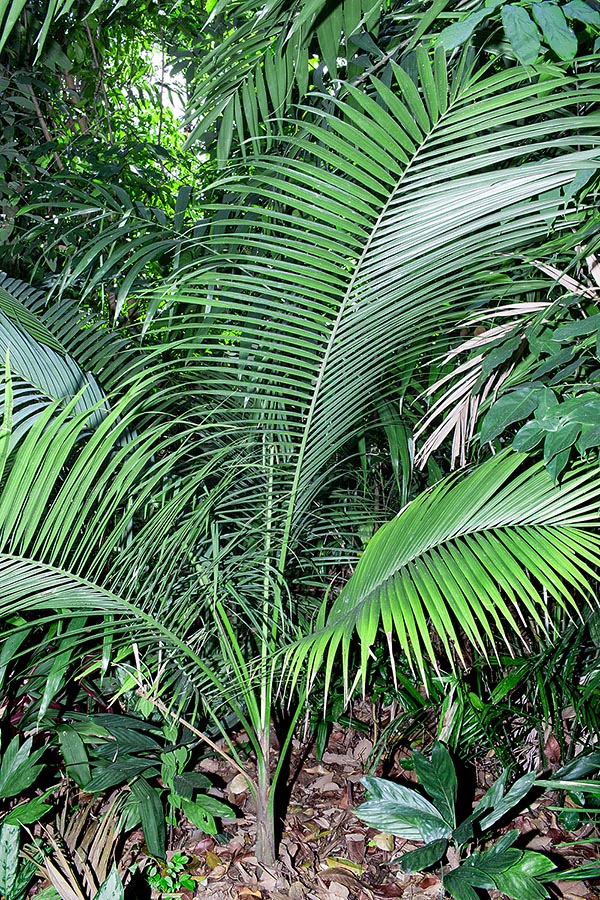Family : Arecaceae

Text © Pietro Puccio

English translation by Mario Beltramini
The species is native to Peninsular Malaysia and Singapore where it grows in the underwood of the humid forests at low altitudes.
The name of the genus is the combination of the Greek substantives “ρόπαλον” (rhopalon) = club, bat and “βλαστός” (blastos) = embryo, with reference to its shape; the specific name is the Latin adjective “singaporensis” = of Singapore, with obvious reference.
Common names: kerinting palm, Malaysian walking stick palm, Singapore walking-stick palm (English); keriting, rinting (Malaysia).
The Rhopaloblaste singaporensis (Becc.) Hook.f. (1883) is an unarmed monoecious cespitous species with few erect stems, up to 3-5 m tall and of 2-4 cm of diameter, of brown grey colour on which are visible the rings trace of the junction of the fallen leaves.

Native to Peninsular Malaysia and Singapore, in humid forests at low altitude, the Rhopaloblaste singaporensis is a cespitous species 3-5 m tall. Of great effect, also in pot, in the tropics © Mazza
It reproduces by seed, previously cleaned from the pulp and kept in lukewarm water for 2 days, in aerated and draining loam maintained humid at the temperature of 26-28 °C, with germination times of 3-4 months.
Species with elegant foliage, paticularly suitable for small gardens due to the reduced size, cultivable exclusively in the tropical and humid subtropical climate zones in position sheltered from the winds and partially shady in the juvenile phase, even in full sun when adult. It requires particularly draining soils and hugh humidity, ambiental as well as in the soil. Of great effect cultivated in pot for the decoration of luminous inner spaces, with lowest winter temperatures not under the 18 °C, utilizing organic loam with addition of siliceous sand or agriperlite per a 30%. The waterings must be regular during the vegetative period in way to maintain the loam constantly humid, but without stagnations that may cause rooting rottenness, spaced in winter, but without ever allowing it to dry up completely. In presence of too dry air recourse can be done to nebulizations with water at ambient temperature and not calcareous, to avoid unaesthetic spots on the leaves, or to place the pot on a wide saucer filled with expanded clay or rubble with a layer of water not in direct contact with the bottom of the pot, in way to create a humid microenvironment around the plant. With the cleaned and varnished stems are made walking sticks, hence the most use common name.
Synonyms: Ptychosperma singaporensis Becc. (1877); Drymophloeus singaporensis (Becc.) Hook.f. (1884); Ptychoraphis singaporensis (Becc.) Becc. (1885); Ptychoraphis longiflora Ridl. (1904).
→ For general notions about ARECACEAE please click here.
